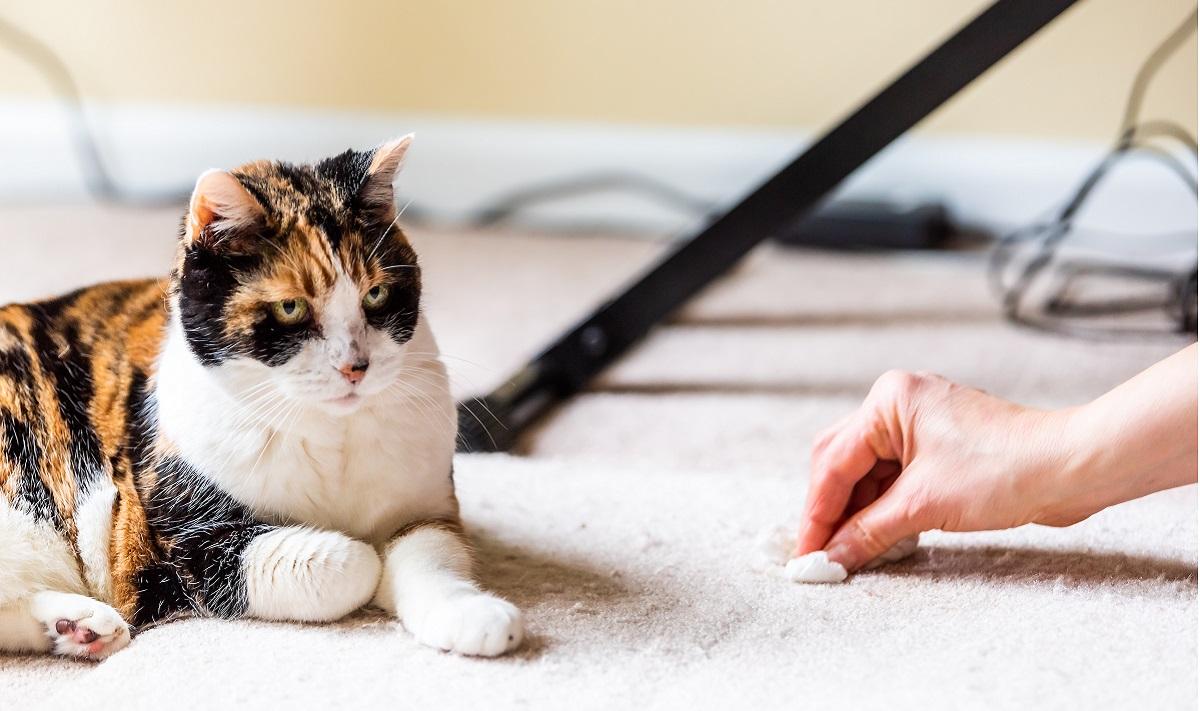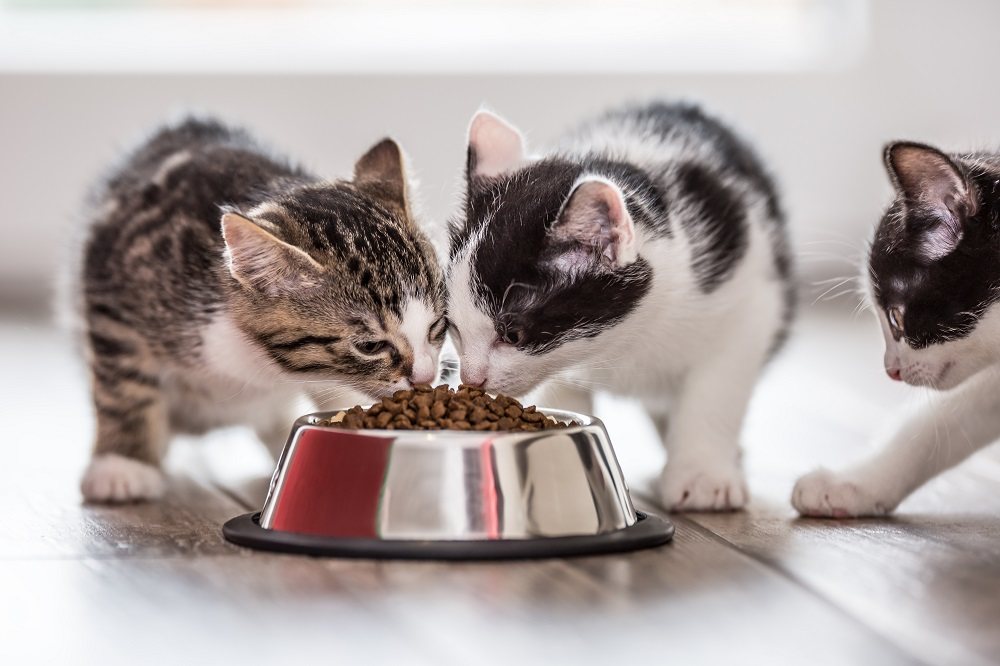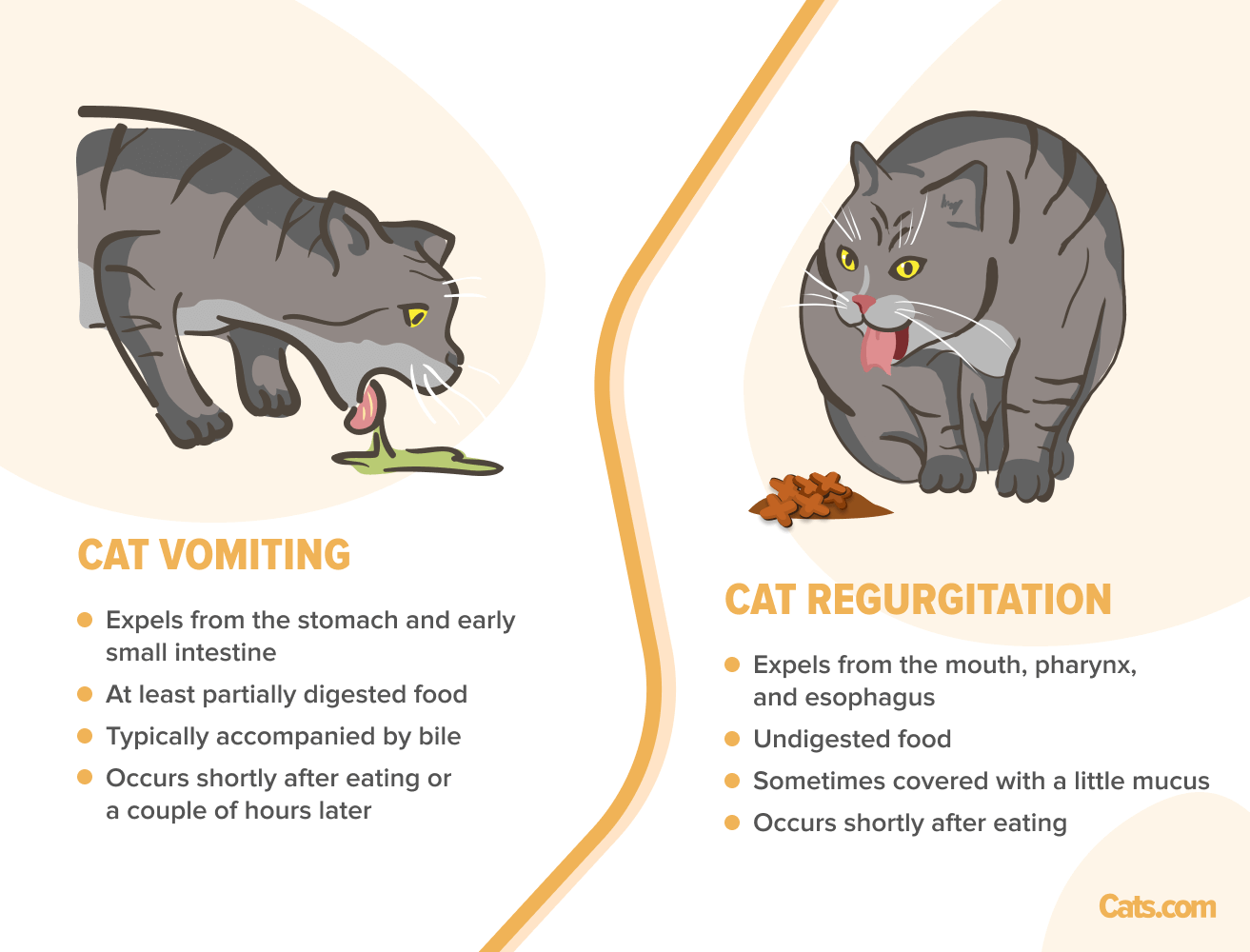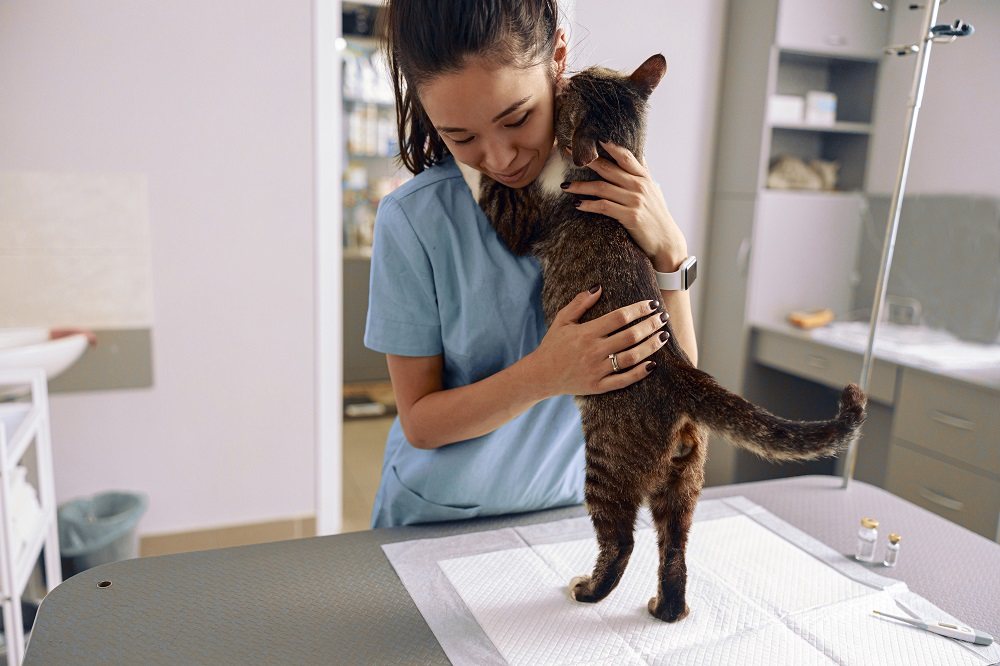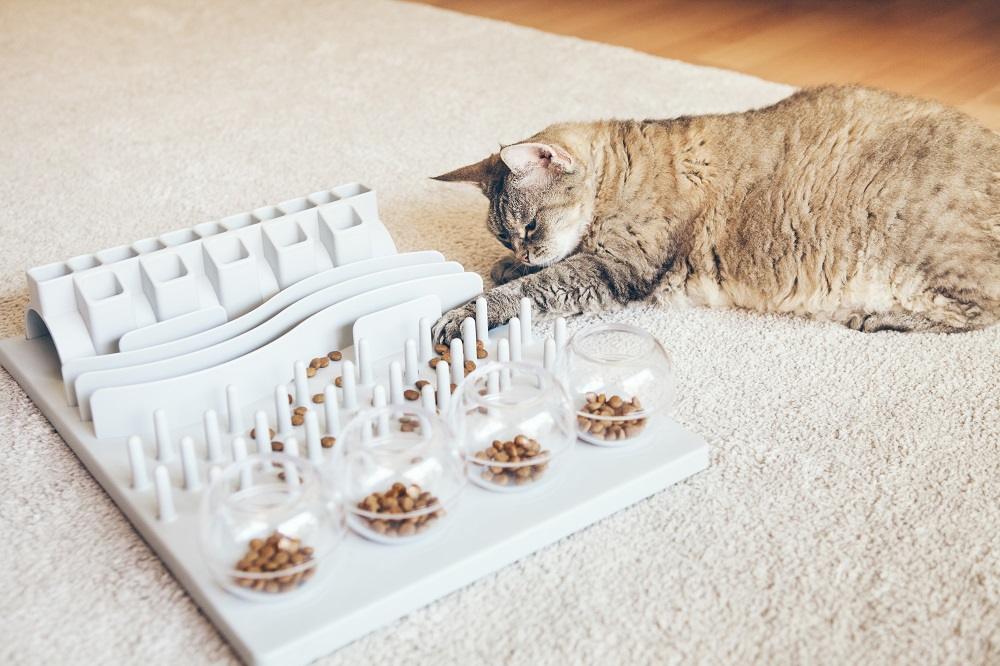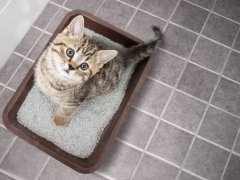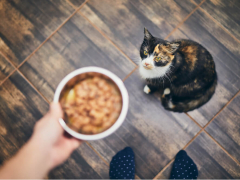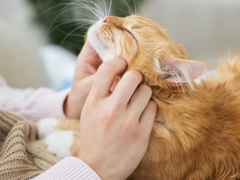While vomit and regurgitation can look similar on your carpet, they’re very different processes with different causes and treatments. Kristi Blokhin / Shutterstock
Long-time cat owners know that their cat’s breakfast may come up and onto the carpet occassionally. While the results can look similar, vomiting and regurgitation in cats are actually very different, with distinct causes and treatments. This article will help you recognize the differences between the two, why your cat might be regurgitating, and what you can do to help.
Causes of Regurgitation in Cats
Regurgitation can occur due to cats eating too quickly. This can happen when cats are fed together, as they can feel a sense of competition. Marian Weyo / Shutterstock
Occasional regurgitation is very common in cats and rarely anything to worry about—especially if they’re in the habit of eating too quickly or too much at once. This often happens when cats are fed together, as it creates competition: They feel they need to eat as much food as possible before someone else takes it! If cats gobble their food without chewing, they tend to take in a lot of air at the same time, which fills up the stomach. The food left in the esophagus is usually regurgitated straight after eating. Having a large drink before or after eating can have the same effect.
Frequent regurgitation, particularly alongside any other symptoms, can be a sign that something is wrong. This is usually a problem in the esophagus—the tube that takes food from your cat’s mouth down to their stomach.
There are several common health conditions that can cause regurgitation in cats.
Esophagitis
Esophagitis, or inflammation of the esophagus, is one of the most common culprits. Lots of things can cause the esophagus to become inflamed, from medications to viruses, acid reflux, anesthesia, cancer, or swallowing irritating substances. Recent vomiting can also cause esophagitis due to the acidity of stomach contents.
While cats with esophagitis will often regurgitate, they usually show other symptoms as well. These include:
- Drooling
- Difficulty swallowing
- Reduced appetite
- Lethargy
- Holding their head and neck extended
If your cat is suffering from esophagitis your veterinarian may recommend treating them with an antacid and pain relief. In very severe cases, they can place a feeding tube directly into the stomach to give the esophagus time to recover, but this is less common.
Motility Disorders
There are a range of disorders that can affect how the esophagus moves, known as motility disorders. These often result in a condition called megaesophagus, where the esophagus becomes dilated (stretched) and can’t move food down to the stomach, resulting in regurgitation. These conditions aren’t as common as esophagitis and are usually accompanied by other symptoms, such as difficulty swallowing, weight loss or poor condition, and breathing issues.
Some motility issues that can cause regurgitation include:
- Myasthenia gravis
- Feline dysautonomia
- Idiopathic megaesophagus
- Certain toxins, including lead and organophosphates
Kittens can be born with a motility disorder or develop one later in life. Motility issues are usually treated with a combination of medication and at-home management strategies.
Esophageal Strictures
An esophageal stricture is a narrowing of the esophagus. This most commonly occurs after an anesthetic, as stomach contents can come up the esophagus when the sphincter muscle between the stomach and esophagus is relaxed. The acid and enzymes from the stomach acid damage the wall of the esophagus, leading to scar tissue that narrows the esophagus tube. This usually happens between 1 and 6 weeks after an anesthetic.
They can also form because of chronic esophagitis (inflammation of the esophagus), trauma to the esophagus from a foreign body, or ingestion of caustic substances.
Strictures can be difficult to diagnose, often requiring advanced procedures such as fluoroscopy or endoscopy. Some strictures can be treated at the same time as endoscopy, using a balloon catheter that inflates to stretch the stricture.
Foreign Objects Stuck in the Esophagus
While cats are not as notorious for swallowing objects as dogs, it does still happen. Bones, string, fish hooks, and hairballs have all been known to get stuck in a cat’s esophagus. The signs of a foreign object in the esophagus usually come on suddenly and include:
- Hypersalivation
- Gagging
- Retching
- Difficulty swallowing
- Regurgitation
- Pawing at the mouth or throat
Foreign bodies will need urgent removal, using either endoscopy or surgery.
Regurgitation in Young Kittens
While regurgitation can be a normal behavior in many cases, I worry more as a vet when I see it occurring frequently in a kitten. This is because regurgitation can be a sign of a range of congenital disorders (conditions young animals can be born with). These include abnormalities in the anatomy of their esophagus, digestive tract, or heart, as well as abnormalities in how their body functions.
Unfortunately, regurgitation in young animals can lead them to inhale their regurgitated food, causing aspiration pneumonia, a potentially life-threatening condition. This is why kittens and young cats with frequent regurgitation should always be examined as soon as possible by a veterinarian, especially if they have any other signs of poor health. The earlier they can be diagnosed and treated, the better.
Cat Regurgitation vs. Vomiting
Vomiting is a very active process in which the stomach contracts to eject its contents. Cats who are about to vomit look restless and may begin drooling, licking their lips, or swallowing. Soon, their tummy begins to heave (usually accompanied by a characteristic moaning or gagging noise) and food, fluid, or froth is expelled rapidly out of their mouth.
When cats regurgitate, the food comes up the esophagus passively, with no contraction of the stomach. There are no signs of nausea beforehand, no heaving of the abdomen, and usually little noise. So, compared to vomiting, regurgitation is much more subtle—the first you might know about it is a puddle on the floor!
Regurgitation tends to happen soon after your cat has eaten, before the food has reached the stomach. As a result, the food reappears undigested, although it might be missed with a bit of saliva or mucus. While cats are often unsettled or distressed during vomiting, you’ll probably find your cat is completely unphased by regurgitating.
When To Call the Vet
While regurgitation isn’t always something to worry about, it’s always a good idea to get your cat checked by a veterinarian if you are concerned. Friends Stock / Shutterstock
If your cat regurgitates their food only on occassion and there are no other symptoms, you likely have nothing to worry about. You might need to look at ways to encourage them to slow down. However, if your cat is bringing up their food or water frequently, it’s time to visit your veterinarian. This especially applies if they are showing any other signs of being unwell, such as:
- Difficulty swallowing
- Poor appetite
- Drooling (hypersalivation)
- Lethargy
- Weight loss or failure to gain weight
- Discomfort around the head or neck
- Breathing issues
If you aren’t sure if your cat is regurgitating or vomiting, it can help to take a video to show your veterinarian. You might worry that your vet will not be thrilled by a video of your cat bringing up their food. But as a veterinarian, I find videos one of the most helpful clues when trying to figure out what’s going on in my patients—even if you think they are a bit gross!
Diagnosis of Regurgitation
If you need to take your cat to the veterinarian for regurgitation, the first thing they will do is listen carefully to what you’ve seen at home. Next, they will do a thorough examination of your cat from nose to tail. However, most cases of regurgitation have to do with a problem in your cat’s esophagus.
Unfortunately, your veterinarian can’t see inside your cat’s esophagus from the outside, so it can be a tricky area to investigate. Therefore, your veterinarian may recommend trying some treatment or management strategies at home initially.
In more serious or persistent cases, your veterinarian will need to see directly inside your cat’s esophagus to figure out what’s going on, usually using endoscopy. This involves placing a flexible tube with a camera on the end down your cat’s throat and into their esophagus and stomach. Your vet will be able to see the inside of your cat’s upper gastrointestinal tract, as well as take biopsy samples if needed.
In suspected cases of motility disorders, they may also recommend a “swallow” study. This uses a special dye to see how food moves through your cat’s gastrointestinal cat on x-rays.
Treating Regurgitation in Cats
Most cats regurgitate their food occasionally, usually because they’ve eaten too much or too fast or had a big drink. If it doesn’t happen frequently and your cat is otherwise well, this is usually considered normal and doesn’t require specific treatment from your veterinarian. But, of course, it is always safest to run any concerns past your veterinarian.
When regurgitation occurs as part of an underlying condition, your cat will likely need either medication (such as with esophagitis or a motility disorder) or a procedure (such as with a foreign body or esophageal stricture) to treat it. Examples of medication commonly used are antacids, pain relief, and occasionally antibiotics. Your veterinarian will give you a full treatment plan after they’ve examined your cat.
However, at-home management is one of the most important factors in managing regurgitation in cats, whether they have a medical problem or not.
Prevention of Regurgitation in Cats: At-Home Care Tips
Slow feeders can help cats slow down while they’re eating (which reduces regurgitation) whilst also providing excellent mental enrichment. Veera / Shutterstock
There are lots of things you can do at home to prevent or reduce regurgitation in your cat: from what they eat to how they eat it. As regurgitation is often caused by eating too much or too fast, a lot of these tips have to do with helping your cat slow their eating down.
- Feed little and often: If your cat is prone to over-eating it can help to offer smaller amounts of food throughout the day. Automatic, timed feeders can be useful if you aren’t home all day.
- Consider a change in diet: Wet food and diets that are low in fat and fiber can be easier for your cat to digest. If your cat prefers kibble, choose a small kibble size, and try soaking it in warm water. Just remember to make any change to your cat’s diet gradually, over at least a week.
- Elevate food and water bowls: Elevating your cat’s bowls allows gravity to help their food and water go down the esophagus easily – and makes it less likely to come back up again.
- Feed your cat on their own: Feeding cats together can cause a feeling of competition, meaning they’re prone to eating quickly. Giving meals separately can help them to slow down without fear of their companion stealing their food!
- Try slow-feeder bowls: Slow-feeder bowls are designed to help your cat slow down while they are eating and are also a great enrichment opportunity. They’re perfect for cats who gobble their food as quickly as possible. However, some cats may swallow more air while using these bowls, which can increase regurgitation. So, keep an eye on what suits your cat best.
The best way to reduce regurgitation in your cat will depend on what is causing it in the first place. All cats are unique and so are their eating habits. So, it is often a process of trial and error to see what changes help your cat the most.
Frequently Asked Questions
Is it normal for cats to regurgitate?
Whilst regurgitation is not 'normal', occasional bringing up of food is very normal in cats. Particularly in those who tend to eat too much food too quickly. But if your cat is regurgitating very frequently, or has other signs of being unwell, it can be a sign of something more serious.
What does regurgitated cat food look like?
Regurgitated food comes directly from your cat's esophagus before it hits the stomach. Therefore, it usually looks like undigested food, possibly with a small amount of liquid or froth. It doesn't contain bile or stomach acid like you might expect to see in vomit.
What can I give my cat for regurgitation?
Unless your cat is regurgitating because of a medical problem, they don't usually require medication. However, there are plenty of things you can do at home to help. These usually involve trying to get your cat to eat smaller amounts of food at a time, more slowly. For instance, giving smaller meals of easily digestible food more frequently, using slow feeder bowls, feeding away from other cats, and elevating food and water bowls.
Should I feed my cat again after regurgitation?
If your cat has regurgitated their food it is usually best to wait a little bit before feeding them again. When you do feed them, it can help to offer a smaller meal so they don't consume too much food too quickly and regurgitate again. Give them the rest of their meal 30-60 minutes later to space it out.
What is the best food for cats with regurgitation?
The best food for regurgitation will depend on the individual cat, and why they are regurgitating. But in general, easily digestible food is usually best. Wet foods with a low fat and fiber content are a good choice. However, if your cat prefers kibble then choose one with small pieces, and try soaking it in warm water to soften it. Whatever the type of food, it usually helps to offer smaller meals more frequently throughout the day.
